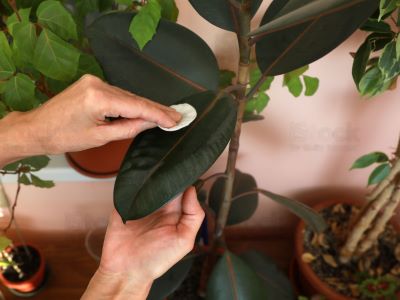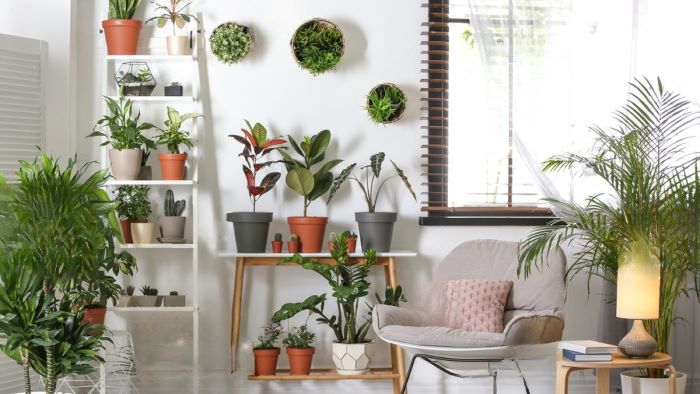If you love having indoor plants in your home, you know how rewarding it can be to see them thrive and beautify your home. But you also know how frustrating it can be to keep them healthy and happy. As we know, indoor plants have different needs and preferences than outdoor plants. So, how to keep indoor plants healthy without losing your mind or killing your green friends?
In this blog post, we will share some tips and tricks that will help you care for your indoor plants like a pro. This guide will help you, whether you are a beginner or an expert.
Let’s get started!
Contents
- 1 Tips to Keep Indoor Plants Healthy!
- 1.1 1. Water Your Plants According to Their Needs
- 1.2 2. Provide Enough Sunlight for Your Plants
- 1.3 3. Fertilize Your Plants Periodically
- 1.4 4. Remove Dust From Your Indoor Plants
- 1.5 5. Prune Your House Plants Regularly
- 1.6 6. Adjust the Temperature of Your Indoor Plants
- 1.7 7. Prevent Pests and Diseases
- 2 FAQs
- 3 Conclusion
Tips to Keep Indoor Plants Healthy!
We can’t deny the fact, that indoor plants can add beauty, freshness, and color to your home. They can also purify the air, reduce stress, and boost your mood. However, indoor plants need proper care and attention to thrive and stay healthy. Here are some tips to keep your indoor plants happy and green.
1. Water Your Plants According to Their Needs
Watering is one of the most important factors of indoor plant care. However, there is no one-size-fits-all rule for how often and how much to water your plants. Different plants have different water requirements, depending on their type, size, potting mix, container, and environment.
The best way to know when to water your plants is to check the soil moisture by touching it with your finger. For example, if the top 1/2 to 1 inch of soil feels dry, it’s time to water. Similarly, if the soil feels damp or wet, wait until it dries out a bit more.

Furthermore, overwatering can cause root rot, fungal infections, and leaf drop, while underwatering can cause wilting, browning, and stunted growth.
It is recommended to use room-temperature water and avoid splashing water on the leaves and stems.
2. Provide Enough Sunlight for Your Plants
As we know, sunlight is essential for photosynthesis, the process by which plants make their own food. Without enough sunlight, your plants will become weak, pale, leggy, and prone to pests and diseases. However, too much direct sunlight can also burn and damage your plants.
The amount of sunlight your plants need depends on their species and origin. Some plants, such as African violets, orchids, and ferns, prefer bright indirect light. Others, such as snake plants, pothos, and ZZ plants, can tolerate low light conditions.

To provide enough sunlight for your plants, you need to consider the orientation of your windows, the season, and the weather. Generally speaking, south-facing windows receive the most sunlight throughout the day.
You may need to move your plants around according to the changing seasons and light levels. Plus, you can also use artificial lights such as fluorescent or LED bulbs to supplement natural light if needed.
3. Fertilize Your Plants Periodically
Fertilizing your plants is another way to provide them with nutrients they need for growth and flowering. However, fertilizing is not necessary all year round. Most indoor plants only need fertilizer during their active growing season, which is usually spring and summer.
The type and amount of fertilizer you use depends on your plant’s needs and preferences. You can choose between organic or synthetic fertilizers, liquid or granular forms, or slow-release or fast-acting formulas.
Always follow the label directions when applying fertilizer to avoid overfeeding or burning your plants.
4. Remove Dust From Your Indoor Plants
Dust can accumulate on your indoor plant’s leaves over time, making them look dull and dirty. It can also block sunlight from reaching the leaves, reducing photosynthesis and plant health. Moreover, dust can attract pests such as spider mites and mealybugs that feed on plant sap.

To remove dust from your indoor plants, you can use a soft cloth or a feather duster to gently wipe each leaf from base to tip. You can also use a spray bottle filled with water to mist your plants lightly and let them air dry. Alternatively, you can take your plants outside or in the shower and rinse them with a gentle stream of water.
You should clean your indoor plants at least once a month or more often if they are in a dusty area.
5. Prune Your House Plants Regularly
Pruning your house plants is another way to keep them healthy and attractive. It involves removing dead, diseased, damaged, or unwanted parts of your plant such as leaves, stems, flowers, or roots.
Pruning has many benefits for your indoor plants:
- It improves their shape and appearance
- Encourages new growth and branching
- Removes potential sources of infection and pest infestation
- It prevents overcrowding and competition for resources
- It stimulates flowering and fruiting
The best time to prune your indoor plants is in late winter or early spring before they start their new growth cycle.
Read More:
6. Adjust the Temperature of Your Indoor Plants
Most indoor plants prefer a moderate and consistent temperature range between 65°F and 75°F during the day and 55°F and 65°F at night. However, some plants may have different preferences depending on their origin and adaptation.
For example, tropical plants such as bromeliads, orchids, and palms like warmer temperatures year-round, while temperate plants such as azaleas, cyclamens, and poinsettias like cooler temperatures in winter.
To adjust the temperature of your indoor plants, you need to consider the following factors:
- Avoid placing your plants near drafty doors or windows, heating or cooling vents, radiators, or fireplaces. As these can cause sudden temperature changes or extremes.
- You can move your plants closer to the window in winter to get more sunlight and heat, or away from the window in summer to avoid overheating.
- It is advisable to protect your plants from extreme weather conditions such as frost, heat waves, or storms.
7. Prevent Pests and Diseases
Pests and diseases are common enemies of indoor plants. They can cause various symptoms such as yellowing, wilting, curling, spotting, dropping, or chewing of leaves, stems, flowers, or fruits. They can also spread from one plant to another and cause serious damage or even death.
To prevent pests and diseases from attacking your indoor plants, you should:
- Inspect your plants regularly for any signs of infestation or infection
- Quarantine any new or infected plants away from other healthy plants
- Avoid overwatering or underwatering your plants
- Remove any dead or diseased parts of your plants
- Use natural or organic methods to control pests and diseases such as neem oil, insecticidal soap, rubbing alcohol, vinegar, baking soda, etc.
With some care, you can enjoy the benefits of having greenery in your home.
Also, read our blog on the easiest indoor plants to keep alive.
FAQs
How to get rid of bugs on indoor plants?
There are several natural methods to get rid of bugs on indoor plants, such as spraying a mixture of water and vinegar, water and dish soap, or neem oil on the plants. These mixtures can help kill or repel some of the bugs that infest plants, such as spider mites, aphids, scale insects, and mealybugs.
How to get rid of spider mites on indoor plants?
Spider mites are tiny pests that suck the sap from plant cells, causing yellow spots, webbing, and leaf drop. To get rid of spider mites on indoor plants, you can use a strong blast of water to dislodge them from the leaves, or wipe them off with a cotton swab dipped in alcohol.
What can I put in my plants to make them healthy?
To make your plants healthy, you need to provide them with the right amount of light, water, temperature, humidity, and fertilizer. Depending on the type of plant, you may need to adjust these factors to suit its needs. You can also put some organic matter, such as compost, worm castings, or coffee grounds, in your plants’ soil to enrich it with nutrients.
How to fertilize indoor plants?
Fertilizing indoor plants can help them grow faster and healthier, but you need to be careful not to overdo it. Too much fertilizer can burn the roots and leaves of your plants or cause salt buildup in the soil. You should follow the instructions on the fertilizer package and apply it only when the plants are actively growing.
Conclusion
In our blog post on keeping indoor plants healthy, we shared some tips and tricks that will help you a lot. The guide includes providing your indoor plants with the right amount of light, water, fertilizer, humidity, and pest control. We hope you have found this guide helpful and informative and that you will apply some of these suggestions to your own plants.
Remember, indoor plants are not only beautiful and decorative, but they also have many benefits for your health and well-being. They can purify the air, reduce stress, boost your mood, and even improve your productivity.
So don’t give up on your indoor plants, and don’t be afraid to experiment and have fun with them. They will reward you with their beauty and vitality.
Happy gardening!

Hi, I’m Jacqueline, the editor-in-chief of cozynest. I have a passion for plants and gardening, also, have a degree in horticulture from the University of California, Davis. I love to share my knowledge and experience with our readers and help them create beautiful and healthy gardens, indoors, and outdoors. I also enjoy experimenting with different plant varieties, designs, and techniques, and learning from other experts in the field. When I’m not working on cozynest, you can find me in my own cozy nest, surrounded by my favorite plants and books.


1 thought on “How to Keep Indoor Plants Healthy?”